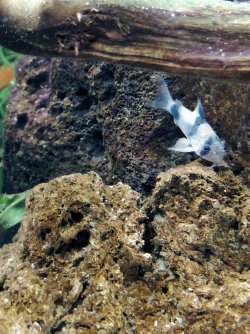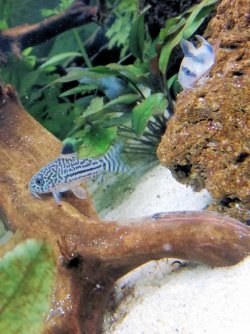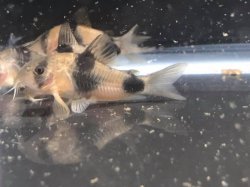You are using an out of date browser. It may not display this or other websites correctly.
You should upgrade or use an alternative browser.
You should upgrade or use an alternative browser.
What type of Cory is this?
- Thread starter lee_k
- Start date
Someone may know the species; I saw these on Ian Fuller's site a few days ago but can't remember the ID. There are so many new cory species being collected these days.
The "leopard" though is Corydoras trilineatus so far as I can tell.
The "leopard" though is Corydoras trilineatus so far as I can tell.
Kritastrophe
Fish Crazy
- Joined
- Jul 24, 2019
- Messages
- 224
- Reaction score
- 92
It kind of looks like a panda Cory, but I’ve never seen one with three stripes. I’ve only seen them with one over the eyes and one by their tail. It’s really pretty whatever it is.
lee_k
Fish Fanatic
It kind of looks like a panda Cory, but I’ve never seen one with three stripes. I’ve only seen them with one over the eyes and one by their tail. It’s really pretty whatever it is.
Thanks - yeah they were really eye catching and plenty in there all the same. I thought maybe "two saddle" from my googling - but i've not seen them before in any of the local shops!
Someone may know the species; I saw these on Ian Fuller's site a few days ago but can't remember the ID. There are so many new cory species being collected these days.
The "leopard" though is Corydoras trilineatus so far as I can tell.
The "Leopards" were actually labelled up as "Corydoras Julii" - I've got 2 Albino in their too but cant remember the name that was on them
Lee
Guppygirl88
New Member
most albinos were bronze it's the most common anyway.Thanks - yeah they were really eye catching and plenty in there all the same. I thought maybe "two saddle" from my googling - but i've not seen them before in any of the local shops!
The "Leopards" were actually labelled up as "Corydoras Julii" - I've got 2 Albino in their too but cant remember the name that was on them
Lee
Guppygirl88
New Member
I thought Panda too but knew it began with m - It is either Metae or Adolfos .
The "Leopards" were actually labelled up as "Corydoras Julii" - I've got 2 Albino in their too but cant remember the name that was on them
For some reason, moist "julii" are in fact Corydoras trilineatus, not the actual C.julii which is very rare. I do not know how this confusion/error began, but it is widespread. Only once or twice in my local area shops have they had the true C. julii but whenever I see "julii" on the tank inevitably they are C. trilineatus. And even more frustrating, once this sort of mistaken ID gets to be common as this one is, it is next to impossible to correct it. The same occurred with C. adolfoi and C. duplicareus; the latter is much more striking in its orange post orbital fleck and the black dorso-lateral stripe, but because no one knew what C. duplicareus referred to, suppliers just tagged them "adolfoi" and it stuck. Here too, every so-called "adolfoi" cory I see is without question C. duplicareus.
One expects common names to be misleading and next to useless, but scientific names delineate a species and having these erroneous is not good.
As for the albinos, there are several species now available in an albino form. C. aeneus, C. paleatus, C. sterbai, and some others I cannot remember. I've no idea how one tells these apart, that's something I have not gone into. To be honest, I do not like albino fish. The colour form (the "albino" are natural, though they are rare in nature but this is legitimate) of these species is quite attractive and I just prefer that.
Back to the panda-like cory, as I said, this is a newly discovered species which may or may not have been described (named) yet. I know I saw them online a few weeks back, but I would never be able to track that down. The species might have a "C" number if not described yet, and assuming it is considered likely a new species. You could search through the photos of "C" numbers on Corydoras World (this is a pay site) or on Planet Catfish (free). There are a lot of them. As new creeks are explored for collecting, dozens of new species of cory are turning up. It is a vast clade of species, with nine distinct lineages which means nine different ancestors evolving into all these species.
I had some free time so I went through the 500+ cory photos on PC and came up with three possibles [these are only the ones pictured, there could be others]. Identifying fish from online photos is risky (my friend Heiko Bleher told me some years ago, don't do it!). I ignored the long-snout possibles as your photos show a rounded snout. Here they are; C. reynoldsi seems closest, but I am not saying any of these is your fish, but they are similar. You will see considerable variation in the several photos of each of these, further evidence that photos alone are not all there is to it.
https://www.planetcatfish.com/common/species.php?species_id=1239
https://www.planetcatfish.com/common/species.php?species_id=15
https://www.planetcatfish.com/common/species.php?species_id=1527
It just occurred to me that your fish will be wild caught imports, so you might find some data on the invoice from the store. The collection site for example, if not the species, could clue you in. You will notes the habitat watercourses are given in the linked data from PC. Most of the cory species are endemic to one stream or creek, except for the widespread species like C. aeneus which is found pretty much all over SA and onto some of the West Indies. But that is the exception, very much.
https://www.planetcatfish.com/common/species.php?species_id=1239
https://www.planetcatfish.com/common/species.php?species_id=15
https://www.planetcatfish.com/common/species.php?species_id=1527
It just occurred to me that your fish will be wild caught imports, so you might find some data on the invoice from the store. The collection site for example, if not the species, could clue you in. You will notes the habitat watercourses are given in the linked data from PC. Most of the cory species are endemic to one stream or creek, except for the widespread species like C. aeneus which is found pretty much all over SA and onto some of the West Indies. But that is the exception, very much.
Last edited:
lee_k
Fish Fanatic
Thanks Byron - i think i agree that the C Reynoldsi looks closest.
I'll get my DLSR out and try and get a nice photo rather than being lazy and using a phone camera!
Lee
I'll get my DLSR out and try and get a nice photo rather than being lazy and using a phone camera!
Lee
The similar cory I was thinking of earlier re-appeared on Ian's site, along with another very similar. So these are two more species that have very similar patterns. Corydoras tukano and C. weitzmani, photos below.
Attachments
lee_k
Fish Fanatic
Well this got solved!
When i got the fish they werent labelled in the tank but I was attracted to there markings.
The guy in the store tried to check the paperwork from the delivery but couldnt find it. They also werent priced so said I could have a few at £5.95 as it was most likely around there!
Well fast forward a few weeks and I was back in the shop so decided have a look around, fish are now labelled up as "Corydoras Weitzmani" and £14.95 each!
Thanks
Lee
When i got the fish they werent labelled in the tank but I was attracted to there markings.
The guy in the store tried to check the paperwork from the delivery but couldnt find it. They also werent priced so said I could have a few at £5.95 as it was most likely around there!
Well fast forward a few weeks and I was back in the shop so decided have a look around, fish are now labelled up as "Corydoras Weitzmani" and £14.95 each!
Thanks
Lee
Great looking cory. As a side note: we might run a Cory only Fish of the Month contest around the middle of October. You might want to enter that Cory.
Similar threads
- Replies
- 9
- Views
- 367
- Replies
- 11
- Views
- 861
- Replies
- 31
- Views
- 4K





